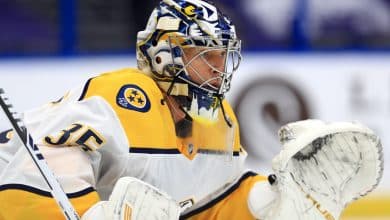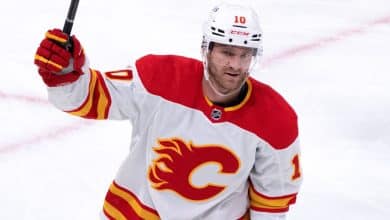
TORONTO – Although satisfied with overtime which allows the impasse to be resolved on average six times out of ten, the NHL and its 32 general managers would like to find a way to energize them a bit or two.
“The three-on-three game generally opens the door to exciting pushes. The problem, and this was predictable, is that over time, head coaches and sent players who are used to taking part in these overtimes have developed habits that slow down the game,” argued Jim Nill.
The Stars general manager, like several of his counterparts when they left the meeting room on Tuesday noon, was referring to the increased attention paid to puck possession.
“Overtime became a quest for puck possession. Teams obviously want to score, but they do everything they can to avoid giving the puck to the opponent. We now see players refusing to shoot towards goal if the opportunity is not optimal. We also see a lot of situations where teams in possession of the puck return to the defensive zone to allow rested players to be sent before relaunching their attack,” added Colin Campbell, senior manager of hockey operations.
This is all very beautiful. But these tactics noted at yesterday’s meeting are completely legal. They even demonstrate healthy puck management.
Why then think about changing the rules?
“Because we always want to improve the quality of the show. Our general managers will take the pulse of their coaches and players and this subject, like all those discussed today, will be explored in depth during the big meeting – three days – next March,” argued Campbell.
The NHL could take inspiration from the NBA to boost its overtime. As we already see in basketball, the NHL could give teams a time limit to shoot a shot towards the opposing net. We could also prohibit a return to the defensive zone, or even the neutral zone, once in the enemy zone with control of the puck.
The idea of extending the extension beyond the five minutes already granted was not discussed on Tuesday, however, underlined Colin Campbell.
Additional protection
On the sidelines of the tragedy which cost the life of Adam Johnson two weeks ago in England, the NHL recommended to its general managers to promote the popularity of wearing protective equipment in order to reduce the risk of serious lacerations to the skin contact with a skate blade.
Hit in the throat by a skate, Adam Johnson, a former member of the Pittsburgh Penguins organization, died following a massive hemorrhage.
“The equipment has been available for over 10 years already,” assured Rod Pasma, NHL vice-president of hockey operations.
“It has also greatly improved in terms of quality of protection while minimizing inconvenience in terms of comfort. It is no longer true that rooms are too big, too bulky, too hot. We have around ten products approved for wrist protection, around a dozen for foot and ankle protection. For the neck, we are working with eight different companies and are about to expand the neck protection pieces to a dozen,” Pasma continued.
Why not impose the wearing of these pieces of equipment if they are as safe and space-saving as the head of the NHL claims?
“It’s a delicate matter. We can encourage the players, but it is impossible to impose a rule without the approval of the players and their association,” indicated Kent Hughes, general manager of the Canadiens.
Clubs should, however, have the right to protect the massive investments they are making in terms of salaries. Salaries that they must pay – directly or through insurance companies – to injured players.
“Perhaps insurance companies will force everyone’s hand by indicating that they will refuse to pay on the assumption that a player has increased his chances of being injured by refusing to protect himself properly. However, I believe that we are far from being there,” commented Jim Nill, CEO of the Stars.
Improved intervention protocols
The filing of criminal charges of manslaughter against the man who shot Johnson in the throat could encourage players and the League to “trivialize” the tragedy by telling themselves that it was not the result of an accident.
That would be a serious mistake.
Because the simple fact that a player can die in a few seconds once hit in the neck should force the hand in terms of protection.
Moreover, young people who arrive in the NHL and who already wore neck protectors, in the junior and university ranks, should be obliged to continue wearing this type of equipment once in the professional ranks.
As we did with the gradual introduction of helmets – now compulsory – and visors worn by the vast majority of players.
Present this morning at the meeting of general managers, the chief physician of the NHL, Willem Meeuwisse, assured that the medical teams of the 32 teams were perfectly able to face cases like the one which cost the life of Adam Johnson.
“These serious accidents are part of the daily life of intensivists employed by our teams. We improved our procedures this year by forcing everyone who might encounter a similar situation – athletic therapists, paramedics present at games and members of team medical staff – to meet before the warm-up period so that they are already in position. able to recognize oneself in the event of an intervention. It can only improve things,” insisted Doctor Meeuwisse.
Instigators on the index
Due to the increase in fights started following legal body checks, the NHL will blacklist the instigators.
It already does this a little while minor penalties for instigator are awarded in 50% of fights following legal body checks.
Just 50%?
“It’s already a good proportion,” assured Stephen Walkom, head of referees.
“It should not be forgotten that in addition to instigator penalties, others for roughness, high stick or unsportsmanlike conduct can be added to a major penalty for fighting,” added the referee manager.
Why not increase the penalties for instigators of fights following legal body checks? Why not add a major penalty, a 10-minute misconduct penalty or simply kick the offenders out of the game?
This would prevent players who deliver strong legal body checks from stopping doing so to avoid having to throw away their gloves afterwards.
Stephen Walkom avoided the question.
A question that will be worth raising again next March when the general managers will meet for three days to deepen the discussions that began Tuesday in Toronto.












